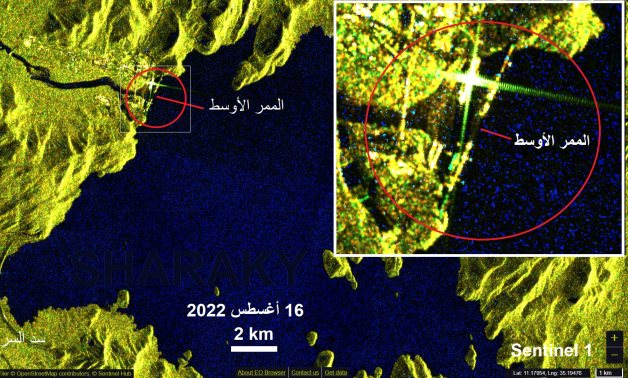
Satellite image of the under-progress Ethiopian Dam taken on August 16, 2022, and posted by renown Egyptian Geologist Abbas Sharaky on his Facebook account.
CAIRO – 16 August 2022: Professor of Geology and Water Resources at Cairo University Abbas Sharaky posted on Facebook Tuesday a satellite image of the Grand Ethiopian Renaissance Dam (GERD) showing the water levels in the reservoir after the third filling carried out in 2022.
"The image of today August 16 shows that the water in the reservoir has just reached the base of the saddle dam but not the body of the original dam. That means there is no pressure on the dam this year. Even if the original dam did not exist, the water would not go beyond that area and would remain in the valley it now blocks. That is why the initial U.S. design of the Renaissance Dam made the dam's reservoir's capacity just 14 billion cubic meters," Sharaky indicated in the post.
The professor elaborated that, "the image shows that the water flows over the middle wall. The level of the reservoir's water will slightly rise in the coming days due to the middle corridor's inability to drain the daily inflow, which can amount to over 700 million cubic meters per day. However, the level will decline again when rain decreases by the end of September."
With regard to the third filling, Sharaky said that it was conducted between July 11 and August 11, and that the quantity of water held is just nine billion cubic meters upping the total in the reservoir to 17 billion cubic meters.
The first filling of the GERD took place on July 1- 21, 2020 with 4.9 billion cubic meters, while the second was carried out on July 4 – 18, 2021 with around three billion cubic meters.
Sharaqi had stated in July that two billion cubic meters had been released since April by opening two gates.
The professor further noted that construction works in the dam would persist for 5-6 years because the middle wall needs to be more heightened for the reservoir's capacity to become 74 billion cubic meters as initially planned.
The dispute among Egypt, Sudan, and Ethiopia dates back to May 2011 when Ethiopia started building the dam; Egypt voiced concern over its water share [55.5 billion cubic meters].
Constructions in the Grand Renaissance Dam started on April 2, 2011 at a cost of $4.8 billion. It was built by the Italian construction and engineering company Salini Impergilo. The dam is located on the Blue Nile with a planned reservoir capacity of 74 billion cubic meters, and was expected to generate up to 6,000 megawatts of power.
However, it is estimated to generate only 3,000 megawatts, as the number of turbines to be installed has been reduced to 13 turbines down from 16. At the beginning of this year, the first turbine was installed but no more so far.
On January 13, Ethiopia declared it would begin removing 17,000 hectares of forests in February, which would take 60 days, to make possible conducting the third filling of the dam.
Comments
Leave a Comment